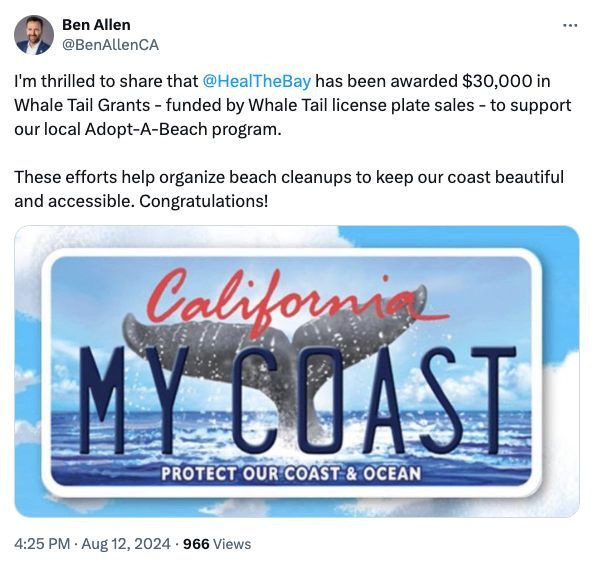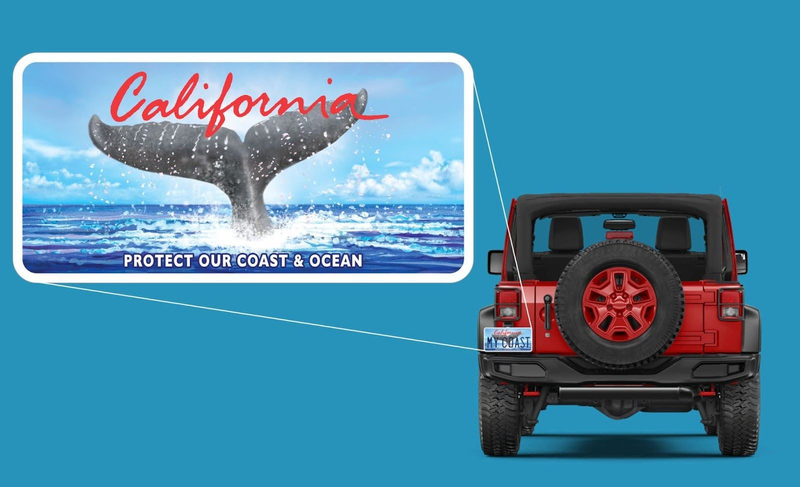Santa Monica-based Heal the Bay, an environmental advocacy group, has been awarded a $30,000 Whale Tail grant funded in part by Whale Tail license plate sales to support the Adopt-A-Beach program.
Whale Tail grants support experiential education and stewardship of the California coast and its watersheds. Grant projects can engage youth or adults and can take place anywhere in California. Approximately $2 million will be distributed in the FY 2023/24 grant cycle, with a maximum award of $50,000. At least 25% of funded projects will be small grants of up to $20,000.
The program is supported through funds allocated through the state budget, donations to the Protect Our Coast and Oceans Fund — a fund listed on the California state tax form, offering taxpayers the option to provide voluntary donations of any amount — and other fundraising endeavors. It is also supported by sales of the Whale Tail Coastal Protection License Plate.
The Whale Tail License Plate is an official specialty license plate issued by the California Department of Motor Vehicles. Proceeds from sales of the plate benefit the California Coastal Commission's Adopt-A-Beach Program, California Coastal Cleanup Day and a wide variety of environmental projects throughout the state. Since the Whale Tail Grants Program began in 1998, it has awarded $23.5 million to 1,007 projects.
"Adopt-A-Beach is a statewide program that the Coastal Commission is the coordinator for statewide, but the program is actually run on the ground by local organizations like Heal the Bay, and it's in almost every coastal County in California," said Christiane Parry, Director of Public Programs, California Coastal Commission, adding, "And there are something like close to 300 adoptable beaches statewide. And if you go on the website, you can see the list of adoptable beaches and beach managers and you can get a sense of the scope of the program."
In Los Angeles County alone, there are 22, including Santa Monica Beach, north or south of the Pier at 1600 block of Ocean Front Walk and Venice Beach, between Washington Blvd, Rose Ave, or Venice Blvd. Parry explains that different cities each have a slightly different approach. Here, in the Santa Monica Bay, lots of people can adopt the same beach, that way, she says, there’s a greater chance that it will remain clean and cared for.

Much of the time, it tends to be school groups, businesses or various other community organizations, but sometimes individual people or families choose to adopt. But in order to adopt, simple commitments must be made, including a minimum number of beach cleans. Heal the Bay organizes beach cleans fairly regularly and often they’ll include an education element too.
"It’s all about trying to be a good steward of the ocean," said Sarah Christie, Legislative Director, California Coastal Commission.
Heal the Bay was founded in 1985 by a group of citizens led by environmental activist Dorothy Green. The organization has become a prominent advocate for the environment in California and is particularly known for its annual report card ratings of the water quality at beaches along the Pacific coast. It was also active in advocating for restrictions on plastic bags in California.
The subject of water quality was recently making headlines again, although this time it was regarding the cleanliness of the River Seine and the Paris Olympics together with the fact that in four short years, the Olympic Games will be coming to Los Angeles. The water quality in Santa Monica Bay is something that’s of great importance to both the California Coastal Commission and Heal the Bay, in particular the area surrounding the Pier.
In November of last year, City Council voted to look into ways to reduce the amount of avian fecal matter that significantly affects the water. The seemingly innocent act of feeding birds near the Pier actually contributes significantly to bacterial contamination in the waters surrounding the iconic Santa Monica landmark, which prompted councilmembers to unanimously approve new rules that prohibit feeding birds and animals in that area.
"The end goal is to get Santa Monica Pier off of the ‘beach bummer list,’ so I am optimistic, but right now, there's just so many questions, it's hard to say what the solutions are going to be," said Annelisa Moe, Associate Director, Science & Policy for Heal the Bay.

She said that since run-off water wasn’t being discharged anymore from the Pier pipe and was instead being redirected to a water treatment facility, the quality has definitely improved.
"I think it was 2018 or 2019 when that facility came online. And actually for a couple of years, we saw an improvement — that was the two years when the Pier came off the ‘bummer list,’ it was still like, a D grade, it wasn't great, but it did improve a little bit,’ Moe said, adding, "But since then, it's declined again. So we know that was an issue and it got addressed. But it's not the silver bullet of what's going to fix water quality."
Moe said that as long as there’s a pier, there will be problems. "When you have food, you have people, you have trash, it’s going to attract birds … There’s also the issue that an area is always in shade, so you don’t get the same UV radiation that can help break down bacteria and things like that," she said.
Heal the Bay is currently in discussions with the City of Santa Monica to put together a task force to look extensively at what has been done and can be done. "I know that the city has done things like putting up bird bedding, although right now, if you go down there and take a look under the pier, it's in disrepair right now. There are definitely major gaps where the netting is ineffective," Moe said.
"The end goal there is to get Santa Monica Pier off of the beach bummer list. So I am optimistic, but right now, there are just so many questions, it's hard to say what the solutions are going to be," Moe said, adding, "Honestly though, if people walk just 100 yards in either direction of the Pier, it's perfectly safe to swim. So it's really just making sure that folks aren't entering the water right there at the Pier.
For more information, visit the coastal.ca.gov website or the Heal the Bay site at healthebay.org.
scott.snowden@smdp.com









